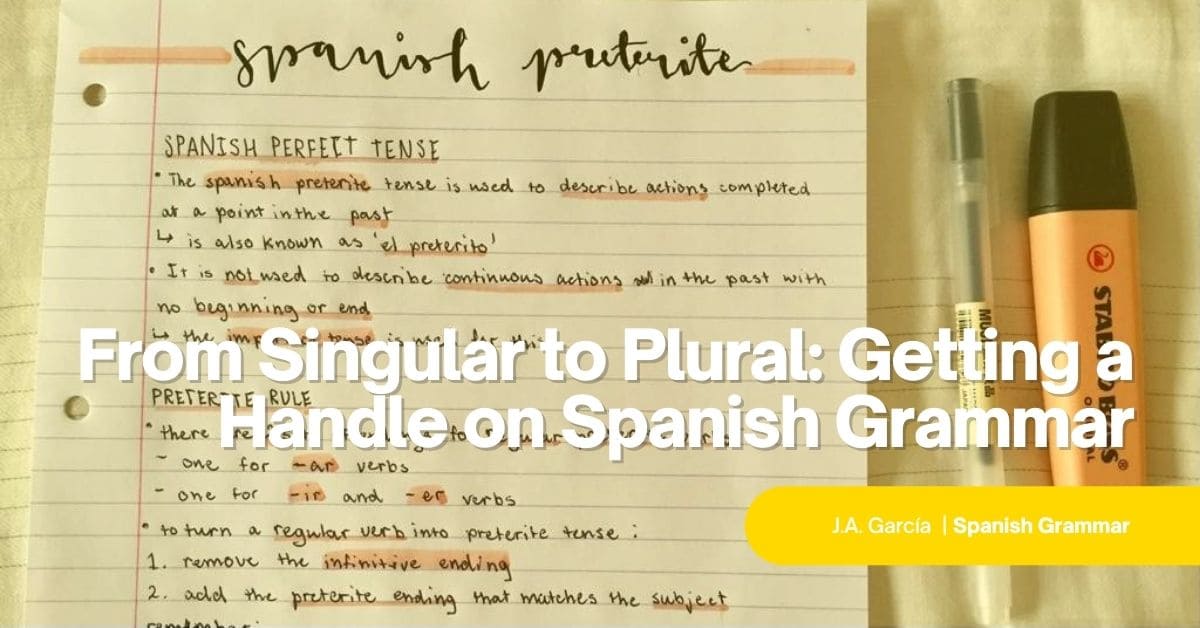
From Singular to Plural: How To Make Spanish Sentences Plural
Just like in English, nouns in Spanish change if they’re singular or plural.
But how to make Spanish sentences plural?
Don’t worry. With this article, you’ll learn how to make that change, and we’ll even give you all the tools you need to practice and be sure to use each correctly.
Let’s go!
Join 559 million people on the planet who speak Spanish!
Sign up for your free trial Spanish class today. ➡️

Spanish Nouns, Adjectives, and Verbs in Plural
Yes, Spanish adjectives, verbs, and even pronouns are spelled one way in singular and differently in plural.
If you know how to turn singular nouns into plural in English, you’re close to learning how to make Spanish sentences plural.
It can be as easy as adding an -s at the end of the noun! But that’s not all.
Once you master singular and plural nouns, you can apply the same rules to adjectives in Spanish.
So, let’s start learning about these Spanish plural rules together.
We recommend: 52 Spanish Connecting Words to Sound Like a Native
1. The basic rule, and the most important one, is that when the noun ends with a vowel without an accent (a, e, i, or u), we must add an –s at the end to make it plural.
Here are some examples:
Libro – Libros
Hombre – Hombres
Casa – Casas
Niña – Niñas
Policía – Policías
Maestro – Maestros
Cuchara – Cucharas
Teléfono – Teléfonos
Carro – Carros
Planeta – Planetas
2. Nouns that end in a consonant need -es at the end to become plural.
Examples:
Escultor – Escultores
Sociedad – Sociedades
Azul – Azules
Mes – Meses
Árbol – Árboles
Hogar – Hogares
Flor – Flores
Amor – Amores
Ciudad – Ciudades
País – Países
3. Some nouns end with an accented vowel, and others only have a single syllable. For these, you usually add -es at the end.
Read the following list:
Hindú – Hindúes
Jabalí – Jabalíes
Colibrí – Colibríes
Bisturí – Bisturíes
Maniquí – Maniquíes
Rubí – Rubíes
Tabú – Tabúes
Bar – Bares
Pez – Peces
Yo – Yoes
Gas – Gases
Gol – Goles
Piel – Pieles
Plan – Planes
However, some people just add an s at the end of these, and it’s also acceptable. So don’t be surprised if you hear or read hindús, jabalís, maniquís, etc.
Must read: 101 Basic Sentences in Spanish Every Beginner Wants to Know
If you want to master this lesson, you must also learn Spanish articles.
Additionally, if you’re speaking Spanish, you must always consider the words’ gender. That doesn’t happen in English.
So, when you write something, always make sure that the article matches its noun both in gender (feminine or masculine) and quantity (singular or plural).
If the word is singular, the article must also be singular. If the noun is feminine, the article must also be feminine.
The articles you can use are:
El – Masculine, singular
Los – Masculine, plural
La – Feminine, singular
Las – Feminine, plural
Un – Masculine, singular
Unos – Masculine, plural
Una – Feminine, singular
Unas – Feminine, plural
Every rule has exceptions. Let’s take a look at some.
4. When a singular noun ends in -ión, you must add the ending –es to make it a plural noun.
It’s important to know that sometimes words drop their accent mark when they become plural.
Examples:
Camión – Camiones
Elección – Elecciones
Mansión – Mansiones
Legión – Legiones
Relación – Relaciones
See also: A Massive List of Spanish Adjectives and How To Use Them
5. For nouns that end in z, add –es at the end and replace the letter z with c.
Examples:
Actriz – Actrices
Cruz – Cruces
Disfraz – Disfraces
Feliz – Felices
Luz – Luces
6. Some plurals in Spanish are written the same in their singular form. In this case, the only thing that must be changed is the article.
Know some examples:
La crisis – Las crisis
La tesis – Las tesis
El lunes – Los lunes
El espantapájaros – Los espantapájaros
El paraguas – Los paraguas
El lavaplatos – Los lavaplatos
You might like: 100+ Basic Spanish Phrases: Fluency From Scratch
Let’s Practice What We Learned!
Now that you have all the basics regarding how to make Spanish sentences plural, it’s time to challenge yourself with some simple exercises to reinforce what you’ve learned.
Let’s do it!
Write the correct plural
1. El pájaro
2. La bicicleta
3. La abeja
4. El queso
5. El pan
6. La rosa
7. El gato
8. El limón
9. El frijol
10. La puerta
Fill in the blanks with the plural form of the nouns in brackets.
1. Las ____________ son muy famosas en México. (actriz)
2. Los ____________ pueden votar en las ___________ del 2023. (hombre, elección)
3. Todos los _______ cantamos karaoke. (jueves)
4. Juan ha decidido comprar dos ________ para nuestra casa. (lavaplatos)
5. Los ojos de María son _______. (azul)
6. Has logrado tonificar los ______ en el gimnasio. (brazo)
7. En la mina encontraron _____ preciosos. (rubí)
8. La maestra nos compró ______ de todos colores. (marcador)
9. Recuerda lavarte las ________ antes de comer. (mano)
10. Los cazadores encontraron muchos _________ en el bosque. (jabalí)
We recommend: 50 Useful Spanish Transition Words for Everyday Speech and Writing
Become an Expert in Spanish Plurals
Remember that everyone has a different learning process, so take your time to practice over and over again.
If you make any mistakes, set smaller, simple, daily goals for yourself.
Look for new techniques to remind you of the most basic rules to help you master the language.
Also, don’t forget that you can practice grammar rules with the simplest activities.
Watch movies or tv series in Spanish.
Find the lyrics of your favorite Spanish songs, write them in your notebook, and highlight the plural nouns, articles, and verbs you find.
The sky’s the limit!
However, one of the best tips we can give you is to take lessons with native Spanish-speaking teachers.
Real human connection will help you reach your fluency goals! At the same time, you’ll learn about other people’s cultures, traditions, and foods! Yum!
So, achieve your learner-specific language goals and continue to discover more exciting grammar rules with our expert-certified curriculum teachers from Guatemala at Homeschool Spanish Academy.
Sign up for a free trial and speak Spanish from your very first class! No payments or credit card details are required.
Click here to check our prices and all of our tailored-made programs.
Your future is waiting for you!

Join one of the 40,000 classes that we teach each month and you can experience results like these…

“This is the best way for your kid to learn Spanish. It’s one-on-one, taught by native Spanish speakers, and uses a curriculum.”
– Sharon K, Parent of 3

“It’s a great way to learn Spanish, from native Spanish speakers in a 1-on-1 environment. It’s been fairly easy to schedule classes around my daughter’s other classes. The best value for us has been ordering multiple classes at a time. All the instructors have been great!”
– Cindy D, Parent of 3

“HSA offers very affordable, quality, one on one classes with a native speaker. My son has greatly benefited from taking classes. We have seen his confidence increase as well as his pronunciation improve, because he learns from a native Spanish speaker. HSA has quick, personal customer service. Our family has been very pleased with our experience so far!”
– Erica P. Parent of 1
Ready to learn more Spanish grammar and vocabulary? Check these out!
- From Snacks to Dinners: Spanish Vocabulary for Food That Teens Actually Talk About
- What to Say When You’re Not Sure What to Say – in Spanish!
- Real Spanish for Real Life: Top Beginner Phrases
- 25 Essential Spanish Phrases for Everyday Conversations
- Avoiding Embarrassing Mistakes: Common False Friends in Spanish
- Llegar vs Llevar in Spanish: What’s the Difference?
- 10 Essential Ways to Use “Que” in Spanish
- Spanish Preterite vs Imperfect: 25 Online Exercises to Practice Your Skills
- 7 Online Spanish Classes for Kids Offering Free Trials - June 28, 2025
- 12 Beginner Spanish Books for Middle School and High School - June 27, 2025
- 8 Places to Learn Spanish in Costa Rica - June 20, 2025





